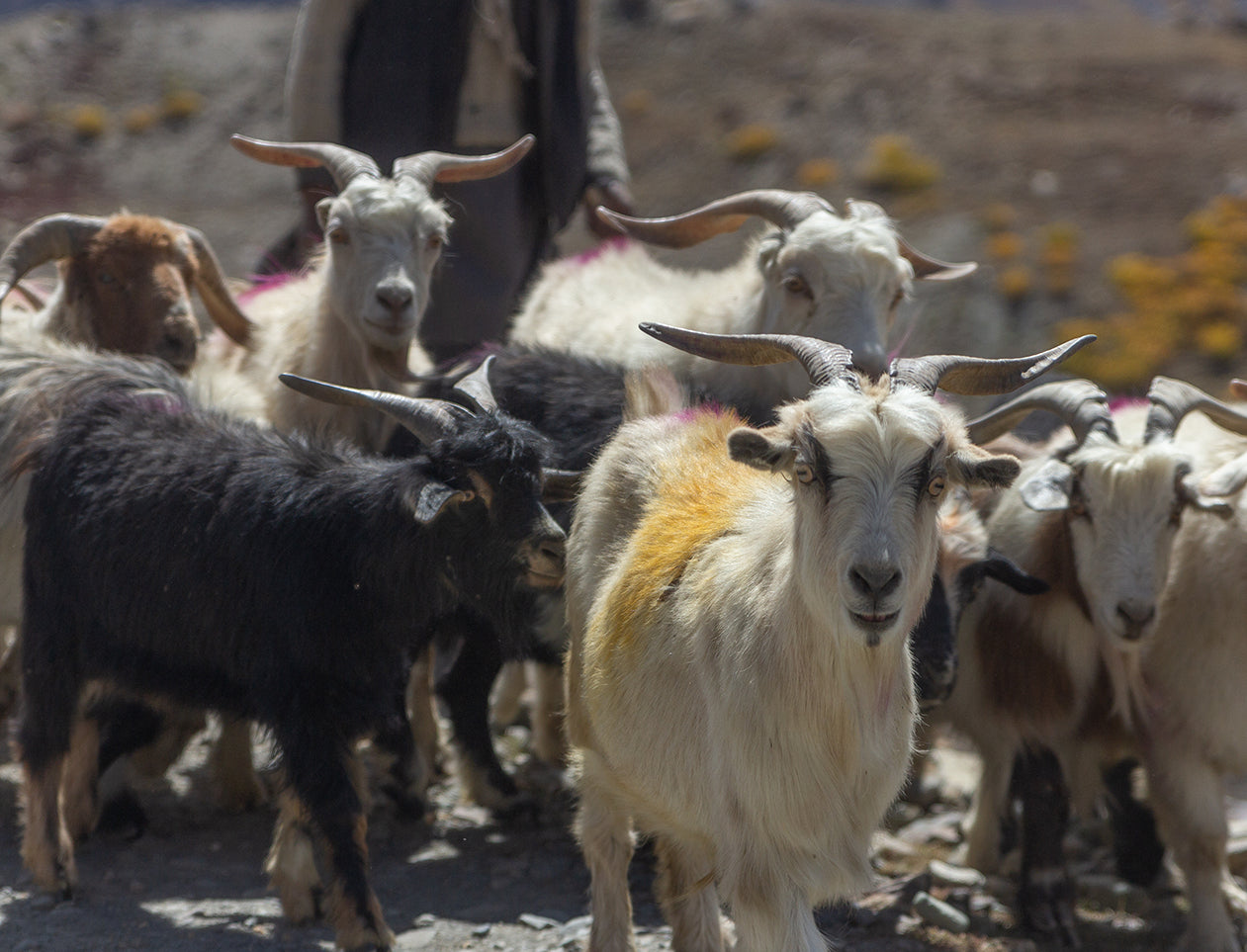
Från naturen, för hand – våra material
Människorna, det äkta hantverket och de ursprungliga materialen i Himalaya, Indien, Norge. Allt skapat för hand av lokala hantverkare i material som vilt sidan, jakull, fårull, pashmina, linne och ekologisk bomull. Infärgat med naturlig indigo, eukalyptus, valnötter, te, blommor, blad, bark, örter mm.
Att väva, spinna och färga för hand med naturens egna material ger varje produkt en mycket speciell och unik känsla. Det är givetvis mer tidsödande och omfattande än processer i den snabba industrin.
Vi vill bidra till ett nytt miljömässigt tankesätt där hantverket får ta tid.
Tillsammans med engagerad kooperativ och små tillverkare tänker vi långsiktigt, hyllar det ursprungliga hantverket och gör det rätta för miljön och människorna.
Vi gör skillnad. SLOW FASHION är framtiden!
Vid varje produkt finns information om materialval och infärgning. Här hittar du fördjupning runt allt material och vår infärgning:
ULL FRÅN FÅR, GET, JAK
Ull från tamdjur har använts mot köld och vind i urminnes tider och tros vara en av de tidigaste använda textila råvarorna. Det är en textil råvara som kammas eller klipp från djuret. Därefter bereds ullen med kamning eller kardning för att sedan spinnas till garn och tråd. Ullen kan även användas till tonning.
Eftersom ullen har benägenhet att brista i längdriktningen har den givit upphov till särskild yllehantering. Olika djurarter har olika typer av ull. Ullfällen består generellt av bottenull och täckhår. Bottenullen är kortfibrigare och mjukare än den täckande. Ull innehåller lanolin, ett fett som täcker ullfibern och har antibakteriella egenskaper som skyddar lukt. Därför säger man att ull är självrenande och smutsavstötande.
Vårda ditt hållbara ullplagg ömt. Vädra! Handtvätta sällan med milt tvättmedel.
FÅRULL
Fåret är efter hunden troligtvis människans tidigaste domesticerade husdjur, nära följt av get. Olika fårraser har mycket olika ull. Vi köper i första hand ull lokalt hos de lokala fåraherdarna.
Vi arbetar med en rad olika ullsorter som:
Tibetansk fårull är långfibrig och mycket varm. Som namnet avslöjar kommer den från ett får som finns på hög höjd på den tibetanska platån. Ullen är slitstark och blir mjukare med tiden. Ofta blandas tibetansk fårull med andra fibrer som merinoull och sidan.
Till flera av sjalarna kommer fårullen från uppköp direkt hos herdar i Himachal Pradesh och distrikten Kullu och Kangra.
Harsilull kommer från Garhwal regionen i Uttarakhand, Himalaya.
MERINOULL
Merino är en fårgrupp av tamfår som främst hålls för ullproduktion och ger en mycket finfibrig ull. Merinofåren har sitt ursprung i Spanien där fårtypen finns dokumenterad sedan 1100-talet. Idag är fårtypen spridd över hela världen. De är sällskapliga och väl lämpad för halvtorra klimat och nomadiserande betesdrift. Merinofår producerar mycket ull och måste klippas regelbundet. Den finfibriga merinoullen kan även användas till att plagga nära kroppen för sina varma egenskaper och för att skapa inte trivsam bra i ullen.
Merinoullen till många sjalar tas från slättlandskapen i Västbengalen, Indien och köps direkt från herdarna i distriktet Himachal Pradesh.
PASHMINAULL
Ofta blandas begreppen kring Pashmina och Kashmirullen ihop. Men det är från två olika getter i olika länder. Pashmina görs av underullen från pashminageten, en getart från länderna på 4-5 000 meters höjd i Himalaya. Den yttersta pälsen är grov. De tunnaste håren finns i det innersta lagret. På våren, då får man börja fälla sin vinter, kammas de för att ta hand om den duniga underullen. På kashmiri heter det ”pashm”, det är därifrån namnet kommer. Pashmina används för att beskriva den allra finaste kashmiren. Fibrerna är enorm tunna. Varje få ger 100–160 gram underull, vilket förstår gör pashminaullen riktigt exklusiv. För att tillverka en enda tröja krävs ull från ca. 10 getter. Pashminasjalar bars traditionellt av 1500-talets mahanaris i Indien. Vår fina, mjuka ull kommer från pashminagetter i Kashmir.
JAKULL
Jak är ett långhårigt oxdjur som lever på högplatåer över 2500 meter i Himalaya, Ryssland, Tibet och Mongoliet. Det finns cirka 14 miljoner domestiserade och 15- 20 000 vilda djur som betar i berg-, skog- och stäpplandskap. Jakull är därför en sällsynt och exklusiv vara som använts av nomader i tusentals år till kläder, tält och filtar. Jakens stora kropp är täckt med tjockt hår med egenskaper som lämpar sig för de mest extrema klimatförhållandena. Jakfibrer är lika jämna och mjuka som kashmir och merinoull men samtidigt varmare än fårull. Jaken tappar sin päls med jämna mellanrum, men fiberrna behåller sina naturliga antibakteriella egenskaper och är totalt luktfri.
Ofta blandar vi jakullen med mjuk merinoull eller sidan för att få den tunnare.
Vi arbetar med paret Ritika och Shaurya i regionen Himachal Pradesh i Himalaya, Indien. Dom gör sina inköp av jakull på en radie av 200 kilometer från sitt distrikt. Dom tvättar, bereder, spinner, väver och färger den fina jakullen med hjälp av lokala hantverkare och av regeringens godkända producenter av den åtråvärda jakullen.
SIDEN
Siden är ett tyg av silkestråden med ursprung från Kina. Sedan 7 000 f.Kr har sedan framställts där, och kunskaperna har spritt till Indien och Japan. Siden är ofta tunt, glansigt, med förmåga att värma och mycket, mycket starkt.
Det finns många olika sidankvaliteter. Största skillnaden är dock hur larven fått utvecklas i sin kokong och på vilka träd och blad den levt. Man skiljer på vilt och ”odlat konventionellt” sedan. Vi arbetar till största delen med det vilda sidan.
VILT SIDEN
I Indien har man fyra olika sk. vildsiden: mulberry, tussah, muga och eri.
Det vilda sidanet framställs i mindre skala och plockas för hand på olika träds blad och i lador i det fria. Kombinationen av larv och blad gör de olika kvaliteterna. Kokongerna plockas efter att larven lämnat den och förvandlats till fjäril.
Det vilda sidanet får en mer ojämn och känslig struktur som förstärks av spinning och vävning för hand. Ibland kallas det vilda sidanet där man låter larven utvecklas till fjäril för Ahimsa, NON VIOLENT SILK ELLER VEGAN SILK…
TUSSAHSIDEN
Det vilda tussahsidenet finns i Kina och Indien och larven lever av bladen på tropiska träd. Tråden är grövre, råare och mer ojämn än tex. mullbärssilkestråden och är vackert beige i sin grundton.
ERISIDEN
På Assamesiska, som talas i delstaden Assam, betyder eri recin. Erilarven lever i det vilda och äter av recinträdets blad, spinner sin kokong som sedan plockas för hand. Tråden i kokongen är väldigt stark och kraftig vilket gör att väven är varm på vintern och sval på sommaren. Larven lämnar kokongen och får utvecklas naturligt till fjäril. Erisiden kallas därför för Ahimsasiden, ickevåldsiden och även vegansiden.
MUGASIDEN
Mugasidenet är det mest exklusiva och finaste sidan av Indiens vilda sida. Kokongerna plockas i det vilda från Lichiaträdets blad i delstaten Assam som är känt för sitt sedanhantverk sedan 3 000-2 000 f.Kr. Det är för sin naturliga skimrande guldaktiga och mycket slitstarka tråd och sin begränsade tillgång som det blivit så efterfrågat och exklusivt.
Vi är mycket tacksamma för att kunna erbjuda detta exklusiva unika sedan som också kallas Ahimsa, ickevåldssiden, då larven får utvecklas i det fria till fjäril.
LINNE
Lin eller Flax är en fiber som odlas i kallare regioner över världen. Linne är en av de äldsta textilierna i världen och går flera tusen år tillbaka i tiden. Lämningar i Georgien har hittats i grottor som är 30 000 år gamla. Både i Mesopotamien och Egypten var materialet förekommande. Linet nämns också ofta i Bibeln.
Fibern är en stark och absorberande fiber som torkar fort. Därför är linne skönt att använda i värme. Textilier gjorda av växten lin är mer känt som linne i västvärlden.
Det vackra linet med fin lyster och mjuk yta har vi hämtat från Västbengalen i Indien. Kunniga hantverkare i Himalaya har spunnit och vävt för hand och sedan färgat med naturliga blommor, blad, bark etc…
EKOBOMULL
Den plats där bomullsplantan odlades av människan först var på Yucatanhalvön i Mexico för 8000 år sedan. Bomullen fördes till Europa runt Kristi födelse på Sidenvägen.
Ekobomull odlas bland annat i Peru, Indien och Afrika och är sedan början av 2000-talet lätt att få tag i. För att få kalla bomullen ekologisk krävs det att den odlas utan några som helst kemiska bekämpningsmedel eller konstgjorda gödningsmedel. För att undvika utarmning av jorden så ska bonden växla mellan olika grödor från år till år.
Vi använder den handvävda ekologiska bomullen från Gujarat, infärgad med Ayurvediska metoder, till yogamattan och yogaplaggen.
